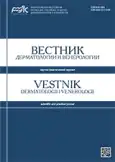Management of patients with congenital epidermolysis bullosa
- Authors: Karamova A.E.1, Albanova V.I.1, Monchakovskaya E.S.1
-
Affiliations:
- State Research Center of Dermatovenereology and Cosmetology, Ministry of Health of the Russian Federation
- Issue: Vol 95, No 4 (2019)
- Pages: 24-30
- Section: REVIEWS
- Submitted: 19.10.2019
- Accepted: 19.10.2019
- Published: 19.08.2019
- URL: https://vestnikdv.ru/jour/article/view/501
- DOI: https://doi.org/10.25208/0042-4609-2019-95-4-24-30
- ID: 501
Cite item
Full Text
Abstract
Congenital epidermolysis bullosa (EB) is a clinically and genetically heterogeneous group of hereditary skin diseases characterized by the formation of blisters and/or erosions in response to minimal trauma. Etiopathogenetic methods for treating the disease are undergoing various stages of clinical research; therefore, external therapy implying caring for affected and non-affected skin remains to be the main treatment method. Such a therapy aims to reduce the healing period of erosive and ulcerative skin defects, thus improving the overall quality of patients’ life. This review sets out to provide clinical recommendations for the management of EB patients developed by different groups of experts, which generalize methods for treating EB patients, main principles of external therapy and relieving subjective sensations, as well as to describe specific situations entailing this pathology.
About the authors
A. E. Karamova
State Research Center of Dermatovenereology and Cosmetology, Ministry of Health of the Russian Federation
Cand. Sci. (Med.), Head of the Dermatology Department,
Korolenko str., 3, bldg 6, Moscow, 107076
Russian FederationV. I. Albanova
State Research Center of Dermatovenereology and Cosmetology, Ministry of Health of the Russian Federation
Author for correspondence.
Email: albanova@rambler.ru
Dr. Sci. (Med.), Assoc. Prof., Leading Researcher, Dermatology Department,
Korolenko str., 3, bldg 6, Moscow, 107076
Russian FederationE. S. Monchakovskaya
State Research Center of Dermatovenereology and Cosmetology, Ministry of Health of the Russian Federation
Junior Researcher, Dermatology Department,
Korolenko str., 3, bldg 6, Moscow, 107076
Russian FederationReferences
- Fine J. D., Eady R. A., Bauer E. A. et al. The classification of inherited epidermolysis bullosa (EB): report of the third international consensus meeting on diagnosis and classification of EB. J Am Acad Dermatol. 2008;58:931–950.
- Fine J. D., Bruckner-Tuderman L., Eady R. A. et al. Inherited epidermolysis bullosa: Updated recommendations on diagnosis and classification. J Am Acad Dermatol. 2014;70:1103–1126.
- Fine J. D. Inherited epidermolysis bullosa. Orphanet J Rare Dis. 2010;5–12.
- Fine J. D., Johnson L. B., Weiner M. et al. Pseudosyndactyly and musculoskeletal deformities in inherited epidermolysis bullosa (EB): experience of the National EB Registry, 1986–2002. J Hand Surg (British and European Volume). 2005;30B:14–22.
- Petrof G., Abdul-Wahab A., McGrath J. A. Cell Therapy in Dermatology. Cold Spring Harb Perspect Med. 2014;4:a015156.
- Nyström A., Bruckner-Tuderman L., Kern J. S. Cell- and protein-based therapy approaches for epidermolysis bullosa. Methods Mol Biol. 2013;961:425–440.
- Georgiadis C., Syed F., Petrova A. et al. Lentiviral engineered fibroblasts expressing codon-optimized COL7A1 restore anchoring fibrils in RDEB. J Invest Dermatol. 2016;136:284–292.
- Hirsch T., Rothoeft T., Teig N. et al. Regeneration of the entire human epidermis using transgenic stem cells. Nature. 2017;551:327–332.
- Carulli S., Contin R., De Rosa L., Pellegrini G., De Luca M. The long and winding road that leads to a cure for epidermolysis bullosa. Regen Med. 2013;8:467–481.
- Pope E., Lara-Corrales I., Mellerio J. et al. A consensus approach to wound care in epidermolysis bullosa. J Am Acad Dermatol. 2012;67(5):904–917.
- Denyer J., Pillay E. Best practice guidelines for skin and wound care in epidermolysis bullosa. International Consensus. DEBRA, 2012.
- Denyer J., Pillay E., Clapham J. Best practice guidelines for skin and wound care in epidermolysis bullosa. An International Consensus. Wounds International. 2017.
- Fine J. D, Mellerio J. Extracutaneous manifestations and complications of inherited epidermolysis bullosa, Part II: other organs. J Am Acad Dermatol. 2009;61:387–402.
- Haynes L. Clinical practice Guidelines for nutrition support in infants and children with epidermolysis bullosa (EB). UK: DEBRA; 2007.
- Cianfarani F., Zambruno G., Castiglia D., Odorisio T. Pathomechanisms of altered wound healing in recessive dystrophic epidermolysis bullosa. Am J Pathol. 2017;187:1445–1453.
- Sindgikar V., Narasanagi B., Tejasvini V., Ragate A., Patel F. A. Effect of serum albumin in wound healing and its related complications in surgical patients. Al Ameen J Med Sci. 2017;10(2):132–135.
- Moss K. Contact at the borderline: psychoanalytic psychotherapy with EB patients. British Journal of Nursing. 2008;17(7):449.
- Snauwaert J. J. L., Yuen W. Y., Jonkman M. F., Moons P., Naulaers G., Morren M. A. Burden of itch in epidermolysis bullosa. Br J Dermatol. 2014;171:73–78.
- Henderson J., Fuguson M., Terenghi G. The feeling of healing. Plast Reconstr Surg. 2012;129:223–224.
- Harding K., Cutting K., Price P. The cost-effectiveness of wound management protocols of care. Вritish Journal оf Nursing. 2000;9(19): Tissue Viability Supplement: S6, S8, S10 passim.
- Azizkhan R. G., Denyer J. E., Mellerio J. E. et al. Surgical management of epidermolysis bullosa: Proceedings of the IInd International Symposium on Epidermolysis Bullosa, Santiago, Chile, 2005. Int J Dermatol. 2007;46:801–808.
- Denyer J. E. The Use of Atraumatic Wound Dressings in Epidermolysis Bullosa. 2006. http://old.ewma.org/fileadmin/user_upload/EWMA/ pdf/conference_abstracts/2006/posters/p172.pdf
- Ly L., Su J. C. Dressings used in epidermolysis bullosa blister wounds: a review. Journal of Wound Care. 2008;17:482, 484–486, 488, passim.
- Nesi-Reis V., Lera-Nonose D., Oyama J. et al. Contribution of photodynamic therapy in wound healing: A systematic review. Photodiagnosis and Photodynamic Therapy. 2018;21:294–305.
- Keast D. H., Bowering C. K., Evans A. W., Mackean G.. L., Burrows C., D’Souza L. MEASURE: a proposed assessment framework for developing best practice recommendations for wound assessment. Wound Repair Regen. 2004;12(3 Suppl):1–17.
- Vanden Oever M., Twaroski K., Osborn M. J. et al. Inside out: regenerative medicine for recessive dystrophic epidermolysis bullosa. Pediatr Res. 2018;83(1–2):318–324.
- Mellerio J. E., Robertson S. J., Bernardis C. et al. Management of cutaneous squamous cell carcinoma in patients with epidermolysis bullosa: best clinical practice guidelines. Br J Dermatol. 2016;174:56–67.
Supplementary files







